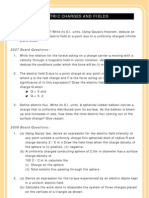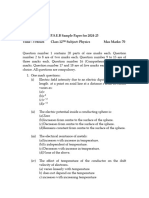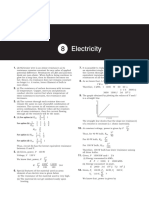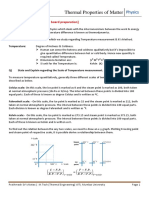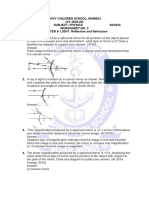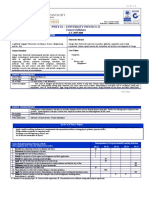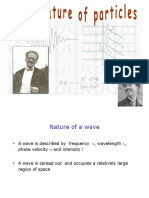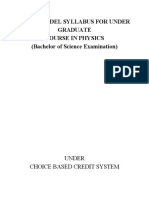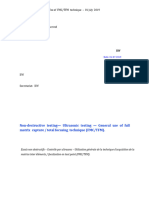Learn Optics in 60 Hours
Learn Optics in 60 Hours
Uploaded by
Danish PrakashCopyright:
Available Formats
Learn Optics in 60 Hours
Learn Optics in 60 Hours
Uploaded by
Danish PrakashOriginal Title
Copyright
Available Formats
Share this document
Did you find this document useful?
Is this content inappropriate?
Copyright:
Available Formats
Learn Optics in 60 Hours
Learn Optics in 60 Hours
Uploaded by
Danish PrakashCopyright:
Available Formats
65
STUDY MATERIAL CLASS XII 2011-12
6. OPTICS
RAY OPTICS
GIST
1. Reflection by convex and concave mirrors.
a. Mirror formula
f u v
1 1 1
= + , where u is the object distance, v is the image distance and f is
the focal length.
b. Magnification
u f
f
f
v f
u
v
m
= = .
m is -ve for real images and +ve for virtual images.
2. Refraction
a. Ray of light bends when it enters from one medium to the other, having different optical
densities.
b. Sun can be seen before actual sunrise and after actual sunset due to Atmospheric
refraction
c. An object under water ( any medium ) appears to be raised due to refraction when
observed inclined
Re
al depth
n
apparent depth
= and
Shift in the position (apparent) of object is
1
1 x t
n
| |
=
|
\ .
Where t is the actual depth of the medium
d. Snells law states that for a given colour of light, the ratio of sine of the angle of incidence to
sine of angle of refraction is a constant.
2
1
sin
n Sini
r n
=
e. Absolute refractive index is the ratio between the velocities of light in vacuum to the
velocity of light in medium. For air n=1.
c
n
v
=
f. When a ray of light travels from denser to rarer medium and if the angle of incidence is
greater than critical angle, the ray of light is reflected back to the denser medium. This
phenomenon is called Total internal reflection.
D
R
n
n
SinC =
g. Diamond has a high refractive index, resulting with a low critical angle (C=24.4
0
). This
promotes a multiple total internal reflection causing its brilliance and luster. Some examples of
total internal reflection are formation of mirage and working of an optical fibre.
h. When light falls on a convex refracting surface, it bends and the relation between U, V and R is
given by
2 1 2 1
n n n n
V u R
=
i. Lensmakers formula or thin lens formula is given by
DOWNLOADED FROM WWW.STUDIESTODAY.COM DOWNLOADED FROM WWW.STUDIESTODAY.COM
DOWNLOADED FROM WWW.STUDIESTODAY.COM DOWNLOADED FROM WWW.STUDIESTODAY.COM
w
w
w
.
s
t
u
d
i
e
s
t
o
d
a
y
.
c
o
m
66
STUDY MATERIAL CLASS XII 2011-12
|
|
.
|
\
|
|
|
.
|
\
|
=
2 1
1 1 1
R R n
n n
f
m
m L
j. For Convex Lens R
1
+ve R
2
ve Concave lens R
1
-ve R
2
+ve
The way in which a lens behaves as converging or diverging depends upon the values of n
L
and
n
m
.
When two lenses are kept in contact the equivalent focal length is given by
2 1
2 1
P P &
1 1 1
P
f f F
+ = + =
1 2 1 2
1 2 1 2
1 1 1
&
when kept at d distance
d
F f f f f
P P P dPP
= +
= +
k. The lens formula is given by
f u v
1 1 1
=
l. When light passes through a glass prism it undergoes refraction.
The expression for refractive index is
|
.
|
\
|
|
.
|
\
| +
=
2
2
A
Sin
D A
Sin
n
As the angle of incidence increases, the angle of deviation decreases, reaches a minimum value and
then increases. This minimum value is called angle of minimum deviation D.
When d=D, angle of incidence = angle of emergence and the refracted ray is parallel to the base of
the prism.
m. For a small angled prism d=(n-1)A
n. When white light (poly chromatic or composite) is passed through a glass prism, It splits up into
its component colours (Monochromatic). This phenomenon is called Dispersion.
o. Scattering of light takes place when size of the particle is very small when compared to the
wavelength of light
p. Intensity of scattered light is
4
1
Io
q. The following properties or phenomena can be explained by scattering.
(i) Sky is blue.
(ii) Sky is reddish at the time of sunrise and sunset
(iii) Infra red photography used in foggy days.
i
d
DOWNLOADED FROM WWW.STUDIESTODAY.COM DOWNLOADED FROM WWW.STUDIESTODAY.COM
DOWNLOADED FROM WWW.STUDIESTODAY.COM DOWNLOADED FROM WWW.STUDIESTODAY.COM
w
w
w
.
s
t
u
d
i
e
s
t
o
d
a
y
.
c
o
m
67
STUDY MATERIAL CLASS XII 2011-12
(iv) Orange colour of black Box
(v) Yellow light used in vehicles on foggy days.
(vi) Red light used in signals.
r. Rainbow is formed due to a combined effect of dispersion, refraction and reflection of sunlight
by spherical water droplets of rain.
QUESTIONS
REFLECTION
1. One half of the reflecting surface of a concave mirror is coated with black paint. How will the
image be affected? (1)
Ans. Brightness decreases
2. Why a concave mirror is preferred for shaving? (1)
Ans. Enlarged image
3. Show that the mirror formula holds good for plane mirror. (1)
Ans. Show that V=-U)
4. Mirrors in search lights are parabolic and not spherical. Why? (2)
Ans. Produce intense parallel beam)
5. Using the mirror formula show that a virtual image is obtained when an object is placed in
between the principal focus and pole of the concave mirror. (2)
Ans. (
1 1 1 1 1
u<f is +ve v
v u f u f
= > )
6. Using the mirror formula show that for a concave mirror, when the object is placed at the centre
of curvature, the image is formed at the centre of curvature. (2)
8. Find the position of an object, which when placed in front of a concave mirror of focal length
20cm, produces a virtual image which is twice the size of the object. (2)
Ans. 10cm
9. * Plot a graph between 1/u and 1/v for a concave mirror. What does the slope of the graph yield?
(2)
Ans. Straight line, slope =u/v=1/m
10. * An object is placed 20cm away from a concave mirror of focal length10cm. A parallel glass slab
which produces a deviation of 3 cm is placed in front of the mirror such that the reflected ray passes
through it. Draw a ray diagram for the image formation and find the position of the final image
formed.
Final position of image=v+ deviation
DOWNLOADED FROM WWW.STUDIESTODAY.COM DOWNLOADED FROM WWW.STUDIESTODAY.COM
DOWNLOADED FROM WWW.STUDIESTODAY.COM DOWNLOADED FROM WWW.STUDIESTODAY.COM
w
w
w
.
s
t
u
d
i
e
s
t
o
d
a
y
.
c
o
m
68
STUDY MATERIAL CLASS XII 2011-12
REFRACTION AND LENSES
1. Which of the following properties of light: Velocity, wavelength and frequency, changes during the
phenomenon (i) reflection (ii) refraction (2)
Ans. (i) No change (ii) velocity, wavelength change)
2. *A convex lens is combined with a concave lens. Draw a ray diagram to show the image formed by
the combination, for an object placed in between f and 2f of the convex lens. Compare the Power of
the convex and concave lenses so that the image formed is real. (3)
Ans. f of convex lens must be less than f of concave lens to produce real image. So power of Convex
greater than that of concave)
3*.Derive a relation between the focal length and radius of curvature of a Plano convex lens made of
glass. Compare the relation with that of a concave mirror. What can you conclude? Justify your
answer.
Ans. (f=2R) both are same. But applicable always in mirrors, but for lenses only in specific cases, the
relation can be applied.)
4.* Show that a concave lens made up of glass when placed in air can act as a converging lens if and
only if the refractive index of air is greater than that of glass.
Ans. (For concave lens
1 2
1 1 1
converging f is to be +ve.
This is possible only when n
l m
m
m l
n n
f n R R
for
n
| || |
= +
| |
\ . \ .
>
5. In the given figure an object is placed at O in a medium (n
2
>n
1
). Draw a ray diagram for the image
formation and hence deduce a relation between u, v and R
(
1 2 1 2
n n n n
v u R
= )
3
4
5
6 Show that a concave lens always produces a virtual image, irrespective of the position of the
object.
Ans.
-ve. that is virtual
uf
v But u is ve and f is ve for concave lens
u f
Hence v is always
=
+
7 Sun glasses are made up of curved surfaces. But the power of the sun glass is zero. Why? (2)
Ans. It is convex concave combination of same powers. So net power zero
8 *A convex lens is differentiated to n regions with different refractive indices. How many images
will be formed by the lens? (2)
Ans. n images but less sharp
O C
n
2
n
1
DOWNLOADED FROM WWW.STUDIESTODAY.COM DOWNLOADED FROM WWW.STUDIESTODAY.COM
DOWNLOADED FROM WWW.STUDIESTODAY.COM DOWNLOADED FROM WWW.STUDIESTODAY.COM
w
w
w
.
s
t
u
d
i
e
s
t
o
d
a
y
.
c
o
m
69
STUDY MATERIAL CLASS XII 2011-12
9 A convex lens has focal length f in air. What happens to the focal length of the lens, if it is
immersed in (i) water (n=4/3) (ii) a medium whose refractive index is twice that of glass. (2)
Ans. 4f, -f
10 Calculate the critical angle for glass air surface, if a ray falling on the surface from air, suffers a
deviation of 15
0
when the angle of incidence is 40
0
.
Ans. Find n by Snells law and then find c=41.14
0
(2)
11 Two thin lenses when in contact produce a net power of +10D. If they are at 0.25m apart, the
net power falls to +6 D. Find the focal lengths of the two lenses (3)
Ans. 0.125m, 0.5m)
PRISM
1 * A glass prism has an angle of minimum deviation D in air. What happens to the value of D if the
prism is immersed in water? (1)
Ans. Decreases
2.* Draw a ray diagram for the path followed by the ray of light passing through a glass prism
immersed in a liquid with refractive index greater than glass. (1)
3. *Three rays of light red (R) green (G) and blue (B) are incident on the surface of a right angled
prism as shown in figure. The refractive indices for the material of the prism for red green and blue
are 1.39, 1.43 and 1.47 respectively. Trace the path of the rays through the prism. How will the
situation change if the rays were falling normally on one of the faces of an equilateral prism? (3)
(Hint Calculate the critical angle for each and if the angle of incidence on the surface AC is greater,
then TIR will take place.)
4. Show that the angle of deviation for a small angled prism is directly proportional to the refractive
index of the material of the prism. One of the glass Prisms used in Fresnels biprism experiment has
refractive index 1.5. Find the angle of minimum deviation if the angle of the prism is 3
0
. (3)
(D= (n-1) A, 1.5
0
)
5. In the given diagram, a ray of light undergoes total internal reflection at the point C which is on
the interface of two different media A and B with refractive indices1.7 and 1.5 respectively. What is
the minimum value of angle of incidence? Can you expect the ray of light to undergo total internal
reflection when it falls at C at the same angle of incidence while entering from B to A. Justify your
answer?
45
0
B
G
R
A
B C
DOWNLOADED FROM WWW.STUDIESTODAY.COM DOWNLOADED FROM WWW.STUDIESTODAY.COM
DOWNLOADED FROM WWW.STUDIESTODAY.COM DOWNLOADED FROM WWW.STUDIESTODAY.COM
w
w
w
.
s
t
u
d
i
e
s
t
o
d
a
y
.
c
o
m
70
STUDY MATERIAL CLASS XII 2011-12
Ans. Use
0
0.88 C=61.7
r
d
n
SinC and
n
= = so i=61.8
0
no for TIR ray of light must travel from
denser to rarer)
6. The velocity of light in flint glass for wavelengths 400nm and 700nm are 1.80x10
8
m/s and 1.86x10
8
m/s respectively. Find the minimum angle of deviation of an equilateral prism made of flint glass for
the given wavelengths.
(For 400nm D=52
0
and for 700nm D=48
0
)
7. In the given diagram a point object is kept at the Focus F of the convex lens. The ray of light from
the lens falls on the surfaces AB and BC of a right angled glass prism of refractive index 1.5 at an
angle 42
0
.Where will be the final image formed? Draw a ray diagram to show the position of the final
image formed. What change do you expect in your answer if the prism is replaced by a plane mirror?
C=41.8
0
Ans- at F itself no change
Optical instruments
GIST
Human eye:
Eye lens: crystalline
Cilliary muscles: lens is held in position by these.
Iris: Circular contractible diaphragm with an aperture near the centre.
Pupil: the circular aperture is pupil. It adjusts controlling light entering the
eye.
Power of accommodation: ability of pupil for adjusting focal length.
Far point: the maximum distant point that an eye can see clearly.
Near point: closest distant that eye lens can focus on the retina.
Range of vision: distant between near point and far point.
Defects of vision:
Myopia: image formed in front of the retina. Correction-using concave lens.
n1=1.7
n
2
=1.5
C
A
B
F
A
B
C
DOWNLOADED FROM WWW.STUDIESTODAY.COM DOWNLOADED FROM WWW.STUDIESTODAY.COM
DOWNLOADED FROM WWW.STUDIESTODAY.COM DOWNLOADED FROM WWW.STUDIESTODAY.COM
w
w
w
.
s
t
u
d
i
e
s
t
o
d
a
y
.
c
o
m
71
STUDY MATERIAL CLASS XII 2011-12
Hypermetropia- image behind the retina. Correction-using convex lens.
Presbiopia-low power of accommodation. Correction-bifocal lens.
Astigmatism-cornea has different curvature in different direction. Correction-using cylindrical
Lens.
DOWNLOADED FROM WWW.STUDIESTODAY.COM DOWNLOADED FROM WWW.STUDIESTODAY.COM
DOWNLOADED FROM WWW.STUDIESTODAY.COM DOWNLOADED FROM WWW.STUDIESTODAY.COM
w
w
w
.
s
t
u
d
i
e
s
t
o
d
a
y
.
c
o
m
72
STUDY MATERIAL CLASS XII 2011-12
Compound Microscope:
Objective: The converging lens nearer to the object.
Eyepiece: The converging lens through which the final image is seen.
Both are of short focal length. Focal length of eyepiece is slightly greater than that of the
objective.
F
o
F
o
F
e
2F
e
2F
o
f
o
f
o
f
e
Ey
e
A
B
A
B
A
B
Objective
Eyepiece
2F
o
A
D
L
v
o
u
o
P
o
P
e
DOWNLOADED FROM WWW.STUDIESTODAY.COM DOWNLOADED FROM WWW.STUDIESTODAY.COM
DOWNLOADED FROM WWW.STUDIESTODAY.COM DOWNLOADED FROM WWW.STUDIESTODAY.COM
w
w
w
.
s
t
u
d
i
e
s
t
o
d
a
y
.
c
o
m
73
STUDY MATERIAL CLASS XII 2011-12
Astronomical Telescope: (Image formed at infinity
Normal Adjustment)
I
Image at
infinity
F
e
F
o
Objective
Eyepiece
f
o
f
e
P
o
P
e
Eye
f
o
+ f
e
= L
Focal length of the objective is much greater than that of the eyepiece.
Aperture of the objective is also large to allow more light to pass through it.
Angular magnification or Magnifying power of a telescope in normal adjustment
Newtonian Telescope: (Reflecting Type)
Concave Mirror
Plane Mirror
Eyepiece
Eye
Light
from star
M=
f
o
f
e
Magnifying Power:
DOWNLOADED FROM WWW.STUDIESTODAY.COM DOWNLOADED FROM WWW.STUDIESTODAY.COM
DOWNLOADED FROM WWW.STUDIESTODAY.COM DOWNLOADED FROM WWW.STUDIESTODAY.COM
w
w
w
.
s
t
u
d
i
e
s
t
o
d
a
y
.
c
o
m
74
STUDY MATERIAL CLASS XII 2011-12
DOWNLOADED FROM WWW.STUDIESTODAY.COM DOWNLOADED FROM WWW.STUDIESTODAY.COM
DOWNLOADED FROM WWW.STUDIESTODAY.COM DOWNLOADED FROM WWW.STUDIESTODAY.COM
w
w
w
.
s
t
u
d
i
e
s
t
o
d
a
y
.
c
o
m
75
STUDY MATERIAL CLASS XII 2011-12
DOWNLOADED FROM WWW.STUDIESTODAY.COM DOWNLOADED FROM WWW.STUDIESTODAY.COM
DOWNLOADED FROM WWW.STUDIESTODAY.COM DOWNLOADED FROM WWW.STUDIESTODAY.COM
w
w
w
.
s
t
u
d
i
e
s
t
o
d
a
y
.
c
o
m
76
STUDY MATERIAL CLASS XII 2011-12
QUESTIONS
Microscope and telescope
*1. You are given following three lenses. Which two lenses will you use as an eyepiece and as
an objective to construct an astronomical telescope?
Lens Power (P) Aperture (A)
L1 3D 8 cm
L2 6D 1 cm
L3 10D 1 cm
Ans- The objective of an astronomical telescope should have the maximum diameter and its
eyepiece should have maximum power. Hence, L1 could be used as an objective and L3
could be used as eyepiece.
2
2. Draw a ray diagram of a reflecting type telescope. State two advantages of this telescope
over a refracting telescope.
2
3. Draw a ray diagram of an astronomical telescope in the normal adjustment position, state
two drawbacks of this type of telescope.
2
4. Draw a ray diagram of a compound microscope. Write the expression for its magnifying
power.
2
5. The magnifying power of an astronomical telescope in the normal adjustment position is
100. The distance between the objective and the eyepiece is 101 cm. Calculate the focal
lengths of the objective and of the eye-piece.
2
6. How does the resolving power of an astronomical telescope get affected on (i) Increasing
the aperture of the objective lens? (ii) Increasing the wavelength of the light used?
2
7. What are the two ways of adjusting the position of the eyepiece while observing the
Final image in a compound microscope? Which of these is usually preferred and why?
Obtain an expression for the magnifying power of a compound microscope. Hence explain
why (i) we prefer both the objective and the eye-piece to have small focal length? and (ii)
we regard the length of the microscope tube to be nearly equal to be separation between
the focal points of its objective and its eye-piece? Calculate the magnification obtained by
a compound microscope having an objective of focal length 1.5cm and an eyepiece of focal
length 2.5 cm and a tube length of 30.
5
8. What are the two main considerations that have to be kept in mind while designing the
objective of an astronomical telescope?
Obtain an expression for the angular magnifying power and the length of the tube of an
astronomical telescope in its normal adjustment position.
An astronomical telescope having an objective of focal length 2m and an eyepiece of focal
length 1cm is used to observe a pair of stars with an actual angular separation of 0.75. What
would be their observed angular separation as seen through the telescope?
Hint- observed angular separation = 0.75 200 = 150
5
*9. Cassegrain telescope uses two mirrors as shown in Fig. Such a telescope is built with the
mirrors 20 mm apart. If the radius of curvature of the large mirror is 220 mm and the small
mirror is 140 mm, where will the final image of an object at infinity be? The following
figure shows a Cassegrain telescope consisting of a concave mirror and a convex mirror.
DOWNLOADED FROM WWW.STUDIESTODAY.COM DOWNLOADED FROM WWW.STUDIESTODAY.COM
DOWNLOADED FROM WWW.STUDIESTODAY.COM DOWNLOADED FROM WWW.STUDIESTODAY.COM
w
w
w
.
s
t
u
d
i
e
s
t
o
d
a
y
.
c
o
m
77
STUDY MATERIAL CLASS XII 2011-12
Distance between the objective mirror and the secondary mirror, d = 20 mm
Radius of curvature of the objective mirror, R
1
= 220 mm
Hence, focal length of the objective mirror,
Radius of curvature of the secondary mirror, R
1
= 140 mm
Hence, focal length of the secondary mirror,
The image of an object placed at infinity, formed by the objective mirror, will act as a
virtual object for the secondary mirror.
Hence, the virtual object distance for the secondary mirror,
Applying the mirror formula for the secondary mirror, we can calculate image distance
(v)as:
Hence, the final image will be formed 315 mm away from the secondary mirror.Light
incident normally on a plane mirror attached to a galvanometer coil retraces backwards as
shown in
*10. The best position of the eye for viewing through a compound microscope is at the eye-
ring attached to the eyepiece. The precise location of the eye depends on the separation
between the objective lens and the eyepiece.An angular magnification (magnifying
power) of 30X is desired using an objective of focal length 1.25 cm and an eyepiece of
focal length 5 cm. How will you set up the compound microscope?
Ans -
Focal length of the objective lens, = 1.25 cm
Focal length of the eyepiece, f
e
= 5 cm
Least distance of distinct vision, d = 25 cm
Angular magnification of the compound
microscope = 30X Total magnifying power of the
compound microscope, m = 30
The angular magnification of the eyepiece is given by the relation:
5
DOWNLOADED FROM WWW.STUDIESTODAY.COM DOWNLOADED FROM WWW.STUDIESTODAY.COM
DOWNLOADED FROM WWW.STUDIESTODAY.COM DOWNLOADED FROM WWW.STUDIESTODAY.COM
w
w
w
.
s
t
u
d
i
e
s
t
o
d
a
y
.
c
o
m
78
STUDY MATERIAL CLASS XII 2011-12
The angular magnification of the objective lens (m
o
) is related to m
e
as: = m
Applying the lens formula for the objective lens:
The object should be placed 1.5 cm away from the objective lens to obtain
the desired magnification.
Applying the lens formula for the eyepiece:
Where,
= Image distance for the eyepiece = d = 25 cm
= Object distance for the eyepiece
DOWNLOADED FROM WWW.STUDIESTODAY.COM DOWNLOADED FROM WWW.STUDIESTODAY.COM
DOWNLOADED FROM WWW.STUDIESTODAY.COM DOWNLOADED FROM WWW.STUDIESTODAY.COM
w
w
w
.
s
t
u
d
i
e
s
t
o
d
a
y
.
c
o
m
79
STUDY MATERIAL CLASS XII 2011-12
Separation between the objective lens and the eyepiece
Defects of vision
1. A myopic person has been using spectacles of power 1.0 dioptre for distant vision.
During old age he also needs to use separate reading glass of power + 2.0 dioptres.
Explain what may have happened.
Ans -
The power of the spectacles used by the myopic person, P = 1.0 D
Focal length of the spectacles,
Hence, the far point of the person is 100 cm. He might have a normal near point of 25 cm.
When he uses the spectacles, the objects placed at infinity produce virtual images at 100
cm. He uses the ability of accommodation of the eye-lens to see the objects placed
between 100 cm and 25 cm.
During old age, the person uses reading glasses of (power, P=100/50)
The ability of accommodation is lost in old age. This defect is called
presbyopia. As a result, he is unable to see clearly the objects placed at 25 cm.
3
2. Answer the following questions:
(a) The angle subtended at the eye by an object is equal to the angle subtended at the
eye by the virtual image produced by a magnifying glass. In what sense then does a
magnifying glass provide angular magnification?
(b) In viewing through a magnifying glass, one usually positions ones eyes very close to
the lens. Does angular magnification change if the eye is moved back?
(c) Magnifying power of a simple microscope is inversely proportional to the focal length of
the lens. What then stops us from using a convex lens of smaller and smaller focal length
and achieving greater and greater magnifying power?
(d) Why must both the objective and the eyepiece of a compound microscope have
short focal lengths?
(e) When viewing through a compound microscope, our eyes should be positioned not
on the eyepiece but a short distance away from it for best viewing. Why? How much
should be that short distance between the eye and eyepiece?
Ans -
(a)Though the image size is bigger than the object, the angular size of the image is equal
to the angular size of the object. A magnifying glass helps one see the objects placed
closer than the least distance of distinct vision (i.e., 25 cm). A closer object causes a larger
angular size. A magnifying glass provides angular magnification. Without magnification,
the object cannot be placed closer to the eye. With magnification, the object can be
placed much closer to the eye.
5
DOWNLOADED FROM WWW.STUDIESTODAY.COM DOWNLOADED FROM WWW.STUDIESTODAY.COM
DOWNLOADED FROM WWW.STUDIESTODAY.COM DOWNLOADED FROM WWW.STUDIESTODAY.COM
w
w
w
.
s
t
u
d
i
e
s
t
o
d
a
y
.
c
o
m
80
STUDY MATERIAL CLASS XII 2011-12
(b) Yes, the angular magnification changes. When the distance between the eye and a
magnifying glass is increased, the angular magnification decreases a little. This is because
the angle subtended at the eye is slightly less than the angle subtended at the lens.
Image distance does not have any effect on angular magnification.
(c) The focal length of a convex lens cannot be decreased by a greater amount. This is
because making lenses having very small focal lengths is not easy. Spherical and
chromatic aberrations are produced by a convex lens having a very small focal length.
(d) The angular magnification produced by the eyepiece of a compound microscope is
Where,
f
e
= Focal length of the eyepiece
It can be inferred that if f
e
is small, then angular magnification of the eyepiece will be large.
The angular magnification of the objective lens of a compound microscope is given as
Where,
= Object distance for the objective lens
= Focal length of the objective
In the case of a microscope, the object is kept close to the objective lens. Hence, the
object distance is very little. Since is small, will be even smaller. Therefore, and
are both small in the given condition.
(e)When we place our eyes too close to the eyepiece of a compound microscope, we are
unable to collect much refracted light. As a result, the field of view decreases
substantially. Hence, the clarity of the image gets blurred.
*3. A man with normal near point (25 cm) reads a book with small print using a
magnifying glass: a thin convex lens of focal length 5 cm.
(a) What is the closest and the farthest distance at which he should keep the lens from
the page so that he can read the book when viewing through the magnifying glass?
(b) What is the maximum and the minimum angular magnification (magnifying power)
possible using the above simple microscope?
Ans -
(a) Focal length of the magnifying
glass, f = 5 cm Least distance of
distance vision, d = 25 cm Closest
object distance = u
Image distance, v = d = 25 cm
According to the lens formula, we have:
Hence, the closest distance at which the person can read the book is 4.167 cm. For the
object at the farthest distant (u), the image distance According to the lens
5
DOWNLOADED FROM WWW.STUDIESTODAY.COM DOWNLOADED FROM WWW.STUDIESTODAY.COM
DOWNLOADED FROM WWW.STUDIESTODAY.COM DOWNLOADED FROM WWW.STUDIESTODAY.COM
w
w
w
.
s
t
u
d
i
e
s
t
o
d
a
y
.
c
o
m
81
STUDY MATERIAL CLASS XII 2011-12
formula, we have:
Hence, the farthest distance at which the person can read the book is 5 cm.
(b) Maximum angular magnification is given by the relation:
Minimum angular magnification is given by the relation:
*4. For a normal eye, the far point is at infinity and the near point of distinct vision is about
25cm in front of the eye. The cornea of the eye provides a converging power of about 40
diopters, and the least converging power of the eye-lens behind the cornea is about 20
diopters. From this rough data estimate the range of accommodation (i.e., the range of
converging power of the eye-lens) of a normal eye.
Least distance of distinct vision, d = 25 cm
Far point of a normal eye,
Converging power of the cornea,
Least converging power of the eye-lens,
To see the objects at infinity, the eye uses its
least converging power.
Power of the eye-lens,
P = Pc + Pe = 40 + 20 = 60 D
Power of the eye-lens is given as:
To focus an object at the near point, object distance (u) = d = 25 cm
Focal length of the eye-lens = Distance between the cornea and the retina
= Image distance
Hence, image distance,
According to the lens formula, we can write:
5
DOWNLOADED FROM WWW.STUDIESTODAY.COM DOWNLOADED FROM WWW.STUDIESTODAY.COM
DOWNLOADED FROM WWW.STUDIESTODAY.COM DOWNLOADED FROM WWW.STUDIESTODAY.COM
w
w
w
.
s
t
u
d
i
e
s
t
o
d
a
y
.
c
o
m
82
STUDY MATERIAL CLASS XII 2011-12
Where,
= Focal length
Wave Optics
GIST
DOWNLOADED FROM WWW.STUDIESTODAY.COM DOWNLOADED FROM WWW.STUDIESTODAY.COM
DOWNLOADED FROM WWW.STUDIESTODAY.COM DOWNLOADED FROM WWW.STUDIESTODAY.COM
w
w
w
.
s
t
u
d
i
e
s
t
o
d
a
y
.
c
o
m
83
STUDY MATERIAL CLASS XII 2011-12
Interference of Waves
DOWNLOADED FROM WWW.STUDIESTODAY.COM DOWNLOADED FROM WWW.STUDIESTODAY.COM
DOWNLOADED FROM WWW.STUDIESTODAY.COM DOWNLOADED FROM WWW.STUDIESTODAY.COM
w
w
w
.
s
t
u
d
i
e
s
t
o
d
a
y
.
c
o
m
84
STUDY MATERIAL CLASS XII 2011-12
DOWNLOADED FROM WWW.STUDIESTODAY.COM DOWNLOADED FROM WWW.STUDIESTODAY.COM
DOWNLOADED FROM WWW.STUDIESTODAY.COM DOWNLOADED FROM WWW.STUDIESTODAY.COM
w
w
w
.
s
t
u
d
i
e
s
t
o
d
a
y
.
c
o
m
85
STUDY MATERIAL CLASS XII 2011-12
Diffraction of light at a single slit:
1) At an angle of diffraction = 0 :
O
0
1
2
3
4
5
6
7
8
9
10
11
12
A
B
= 0
Slit
Screen
Plane
Wavefront
The wavelets from the single wavefront reach the centre O on
the screen in same phase and hence interfere constructively
to give Central or Primary Maximum (Bright fringe).
Bright
D
d
B
A
Slit
Screen
2) At an angle of diffraction =
1
:
The wavelets from the single wavefront diffract at an angle
1
such
that BN is and reach the point P
1
. The pairs (0,6), (1,7), (2,8), (3,9),
(4,10), (5,11) and (6,12) interfere destructively with path difference
/2 and give First Secondary Minimum (Dark fringe).
O
0
1
2
3
4
5
6
7
8
9
10
11
12
P
1
N
1
/2
Plane
Wavefront
Bright
Dark
The slit is imagined to be divided into 2 equal halves.
O
0
1
2
3
4
5
6
7
8
9
10
11
12
A
B
= 0
Slit
Screen
Plane
Wavefront
O
0
1
2
3
4
5
6
7
8
9
10
11
12
P
1
N
A
B
1
1
/2
Slit
Screen
Plane
Wavefront
O
0
1
2
3
4
5
6
7
8
9
10
11
12
P
1
N
A
B
/2
P
1
3/2
P
2
Slit
Screen
Plane
Wavefront
Diffraction at various angles:
I
2
= 0
Central Maximum is the brightest fringe.
Diffraction is not visible after a few order of diffraction.
O
0
1
2
3
4
5
6
7
8
9
10
11
12
P
1
N
A
B 2
2
/2
P
2
3/2
Slit
Screen
Plane
Wavefront
P
1
DOWNLOADED FROM WWW.STUDIESTODAY.COM DOWNLOADED FROM WWW.STUDIESTODAY.COM
DOWNLOADED FROM WWW.STUDIESTODAY.COM DOWNLOADED FROM WWW.STUDIESTODAY.COM
w
w
w
.
s
t
u
d
i
e
s
t
o
d
a
y
.
c
o
m
86
STUDY MATERIAL CLASS XII 2011-12
Width of Central Maximum:
O
0
1
2
3
4
5
6
7
8
9
10
11
12
P
1
N
A
B
1
1
/2
Slit
Screen
Plane
Wavefront
Bright
Dark
D
d
y
1
y
1
= D / d
Since the Central Maximum is
spread on either side of O, the
width is
0
= 2D / d
DOWNLOADED FROM WWW.STUDIESTODAY.COM DOWNLOADED FROM WWW.STUDIESTODAY.COM
DOWNLOADED FROM WWW.STUDIESTODAY.COM DOWNLOADED FROM WWW.STUDIESTODAY.COM
w
w
w
.
s
t
u
d
i
e
s
t
o
d
a
y
.
c
o
m
87
STUDY MATERIAL CLASS XII 2011-12
Malus Law:
When a beam of plane polarised light is incident on an analyser, the intensity I of light transmitted
from the analyser varies directly as the square of the cosine of the angle between the planes of
transmission of analyser and polariser.
DOWNLOADED FROM WWW.STUDIESTODAY.COM DOWNLOADED FROM WWW.STUDIESTODAY.COM
DOWNLOADED FROM WWW.STUDIESTODAY.COM DOWNLOADED FROM WWW.STUDIESTODAY.COM
w
w
w
.
s
t
u
d
i
e
s
t
o
d
a
y
.
c
o
m
88
STUDY MATERIAL CLASS XII 2011-12
Polarisation by Reflection and Brewsters Law:
DOWNLOADED FROM WWW.STUDIESTODAY.COM DOWNLOADED FROM WWW.STUDIESTODAY.COM
DOWNLOADED FROM WWW.STUDIESTODAY.COM DOWNLOADED FROM WWW.STUDIESTODAY.COM
w
w
w
.
s
t
u
d
i
e
s
t
o
d
a
y
.
c
o
m
89
STUDY MATERIAL CLASS XII 2011-12
CONCEPT MAP
DOWNLOADED FROM WWW.STUDIESTODAY.COM DOWNLOADED FROM WWW.STUDIESTODAY.COM
DOWNLOADED FROM WWW.STUDIESTODAY.COM DOWNLOADED FROM WWW.STUDIESTODAY.COM
w
w
w
.
s
t
u
d
i
e
s
t
o
d
a
y
.
c
o
m
90
STUDY MATERIAL CLASS XII 2011-12
QUESTIONS
Huygen's Principle
1. Draw a diagram to show the refraction of a plane wave front incident on a convex lens and
hence draw the refracted wave front.
1
2. What type of wavefront will emerge from a (i) point source, and (ii) distance light source? 1
3. Define the term wave front? Using Huygens construction draw a figure showing the
propagation of a plane wave reflecting at the interface of the two media. Show that the angle
of incidence is equal to the angle of reflection.
3
4. Define the term wavefront. Draw the wavefront and corresponding rays in the case of a (i)
diverging spherical wave (ii) plane wave.Using Huygens construction of a wavefront, explain
the refraction of a plane wavefront at a plane surface and hence deduce Snells law.
3
Interference
1. How does the angular separation of interference fringes change, in Youngs experiment, when
the distance between the slits is increased?
Ans-when separation between slits (d) is increased, fringe width decreases.
1
2. How the angular separation of interference fringes in young woulds double slit experiment
change when the distance of separation between the slits and the screen is doubled?
Ans-No effect (or the angular separation remains the same)
1
*3. In double-slit experiment using light of wavelength 600 nm, the angular width of a fringe
formed on a distant screen is 0.1. What is the spacing between the two slits?
Ans- The spacing between the slits is
2
*4. If the path difference produced due to interference of light coming out of two slits for yellow
colour of light at a point on the screen be 3/2, what will be the colour of the fringe at that
point? Give reasons.
Ans. The given path difference satisfies the condition for the minimum of intensity for yellow
light, Hence when yellow light is used, a dark fringe will be formed at the given point. If white
light is used, all components of white light except the yellow one would be present at that
point.
2
5. State two conditions to obtain sustained interference of light. In Youngs double slit
experiment, using light of wavelength 400 nm, interference fringes of width X are obtained.
The wavelength of light is increased to 600 nm and the separation between the slits is halved.
In order to maintain same fringe with, by what distance the screen is to be moved? Find the
ration of the distance of the screen in the above two cases.
Ans-Ratio-3:1
3
6. Two narrow slits are illuminated by a single monochromatic source. Name the pattern
obtained on the screen. One of the slits is now completely covered. What is the name of the
pattern now obtained on the screen? Draw intensity pattern obtained in the two cases. Also
write two differences between the patterns obtained in the above two cases.
3
*7. In Youngs double-slit experiment a monochromatic light of wavelength , is used. The
intensity of light at a point on the screen where path difference is is estimated as K units.
What is the intensity of light at a point where path difference is /3?
Ans-K/4
3
*8. A beam of light consisting of two wavelengths, 650 nm and 520 nm, is used to obtain
interference fringes in a Youngs double-slit experiment.(a) Find the distance of the third
bright fringe on the screen from the central maximum for wavelength 650 nm.(b) What is the
least distance from the central maximum where the bright fringes due to both the
3
DOWNLOADED FROM WWW.STUDIESTODAY.COM DOWNLOADED FROM WWW.STUDIESTODAY.COM
DOWNLOADED FROM WWW.STUDIESTODAY.COM DOWNLOADED FROM WWW.STUDIESTODAY.COM
w
w
w
.
s
t
u
d
i
e
s
t
o
d
a
y
.
c
o
m
91
STUDY MATERIAL CLASS XII 2011-12
wavelengths coincide?
Ans-a)
b)
*9. In a double-slit experiment the angular width of a fringe is found to be 0.2 on a screen
placed 1 m away. The wavelength of light used is 600 nm. What will be the angular width of
the fringe if the entire experimental apparatus is immersed in water? Take refractive index
of water to be 4/3.
Ans-
3
*10 A narrow monochromatic beam of light of intensity I is incident a glass plate. Another
identical glass plate is kept close to the first one and parallel to it. Each plate reflects 25% of
the incident light and transmits the reaming. Calculate the ratio of minimum and maximum
intensity in the interference pattern formed by the two beams obtained after reflection from
each plate.
Ans. Let I be the intensity of beam I incident on first glass plate. Each plate reflects 25% of
light incident on it and transmits 75%.
Therefore,
I1 =I; and I2 = 25/100I = I/4;I3 =75/100 I = 3/4I;I4 = 25/100 I3 = 14 x 34 I = 3/16 I
I5= 7/100 I4= 34 x 3/16 I = 9/64 I
Amplitude ratio of beams 2 and 5 is R = I2/I5 = I/4 x 64/91 = 4/3
Imin/ Imax = [r-1/r+1]2 = [4/3-1 / 4/3+1]2 = 1/49 = 1:49
3
*11 In a two slit experiment with monochromatic light, fringes are obtained on a screen placed at
some distance D from the slits. If the screen is moved 5 x 10
-2
m towards the slits, the charge
in fringe width is 3 x 10
-5
m. If the distance between the slit is 10
-3
m. Calculate the
wavelength of the light used.
Ans. The fringe width in the two cases will be = D/d; = D/d
- = (D-D)/d; or wavelength = ( - )d / (D-D) But D-D = 5 x 10
-2
m
- = 3 x 10
-5
m , d= 10
-3
m; = 3 x 10
-5
x 10
-3
/ 5 x 10
-2
= 6 x 10
-7
m= 6000A
12. Two Sources of Intensity I and 4I are used in an interference experiment. Find the intensity at
points where the waves from two sources superimpose with a phase difference (i) zero (ii) /2
(iii) .
Ans-The resultant intensity at a point where phase difference is is I
R
= I
1
+I
2
+2I
1
I
2
Cos
DOWNLOADED FROM WWW.STUDIESTODAY.COM DOWNLOADED FROM WWW.STUDIESTODAY.COM
DOWNLOADED FROM WWW.STUDIESTODAY.COM DOWNLOADED FROM WWW.STUDIESTODAY.COM
w
w
w
.
s
t
u
d
i
e
s
t
o
d
a
y
.
c
o
m
92
STUDY MATERIAL CLASS XII 2011-12
As I1 =I and I
2
= 4I therefore I
R
= I +4I+21.4I Cos = 5I +4I cos
(i) when =0 , I R = 5I +4I cos 0 = 9 I;(ii) when =/2 , I R = 5I +4I cos /2 = 5 I
(iii) when = , I R = 5I +4I cos = I
13. What are coherent sources of light? Two slits in Youngs double slit experiment are
illuminated by two different sodium lamps emitting light of the same wavelength. Why is no
interference pattern observed?
(b) Obtain the condition for getting dark and bright fringes in Youngs experiment. Hence
write the expression for the fringe width.
(c) If S is the size of the source and its distance from the plane of the two slits, what should be
the criterion for the interference fringes to be seen?
Ans-c)
5
14. What are coherent sources? Why are coherent sources required to produce interference of
light? Give an example of interference of light in everyday life. In Youngs double slit
experiment, the two slits are 0.03 cm apart and the screen is placed at a distance of 1.5 m
away from the slits. The distance between the central bright fringe and fourth bright fringe is
1 cm. Calculate the wavelength of light used.
Ans-(Numerical part)
5
15. What is interference of light? Write two essential conditions for sustained interference
pattern to be produced on the screen. Draw a graph showing the variation of intensity versus
the position on the screen in Youngs experiment when (a) both the slits are opened and (b)
one of the slit is closed. What is the effect on the interference pattern in Youngs double slit
experiment when: (i) Screen is moved closer to the plane of slits? (ii)Separation between two
slits is increased. Explain your answer in each case.
5
Diffraction
*1. Why a coloured spectrum is seen, when we look through a muslin cloth and not in other clothes?
Ans. Muslin cloth is made of very fine threads and as such fine slits are formed. White light passing
through these silts gets diffracted giving rise to colored spectrum. The central maximum is white
while the secondary maxima are coloured. This is because the positions of secondary maxima
(except central maximum) depend on the wavelength of light. In a coarse cloth, the slits formed
between the threads are wider and the diffraction is not so pronounced. Hence no such spectrum
is seen.
2
2. A parallel beam of light of wavelength 600 nm is incident normally on a slit of width a. If the
distance between the slits and the screen is 0.8 m and the distance of 2nd order maximum from
the centre of the screen is 15 mm, calculate the width of the slit.
Ans-Difference between interference and diffraction: Interference is due to superposition of two
distinct waves coming from two coherent sources. Diffraction is due to superposition of the
secondary wavelets generated from different parts of the same wavefront.
Numerical: Here, = 600 nm = 600 1019 = 6 107 m
D = 0.8 m, x = 15 mm = 1.5 103 m, n = 2, a = ?
2
DOWNLOADED FROM WWW.STUDIESTODAY.COM DOWNLOADED FROM WWW.STUDIESTODAY.COM
DOWNLOADED FROM WWW.STUDIESTODAY.COM DOWNLOADED FROM WWW.STUDIESTODAY.COM
w
w
w
.
s
t
u
d
i
e
s
t
o
d
a
y
.
c
o
m
93
STUDY MATERIAL CLASS XII 2011-12
3. Answer the following questions:
(a) How does the size and intensity of the central maxima changes when the width of the slit
is double in a single slit diffraction experiment?
(b) In what way is diffraction from each slit related to the interference pattern in a double-
slit experiment?
(c) When a tiny circular obstacle is placed in the path of light from a distant source, a bright spot
is seen at the centre of the shadow of the obstacle. Explain why?
(d) Two students are separated by a 7 m partition wall in a room 10 m high. If both light and
sound waves can bend around obstacles, how is it that the students are unable to see each
other even though they can converse easily?
Ans-
(a) In a single slit diffraction experiment, if the width of the slit is made double the original width,
then the size of the central diffraction band reduces to half and the intensity of the central
diffraction band increases up to four times.
(b) The interference pattern in a double-slit experiment is modulated by diffraction from each
slit. The pattern is the result of the interference of the diffracted wave from each slit.
(c) When a tiny circular obstacle is placed in the path of light from a distant source, a bright spot
is seen at the centre of the shadow of the obstacle. This is because light waves are diffracted
from the edge of the circular obstacle, which interferes constructively at the centre of the
shadow. This constructive interference produces a bright spot.
(d) Bending of waves by obstacles by a large angle is possible when the size of the obstacle
is comparable to the wavelength of the waves.
On the one hand, the wavelength of the light waves is too small in comparison to the size of the
obstacle. Thus, the diffraction angle will be very small. Hence, the students are unable to see
each other. On the other hand, the size of the wall is comparable to the wavelength of the
sound waves. Thus, the bending of the waves takes place at a large angle. Hence, the students
are able to hear each other.
2
4. Why light ways do not diffracted around buildings, while radiowaves diffract easily?
Ans- For diffraction to take place the wave length should be of the order of the size of the obstacle.
The radio waves (particularly short radio waves) have wave length of the order of the size of the
building and other obstacles coming in their way and hence they easily get diffracted. Since
wavelength of the light waves is very small, they are not diffracted by the buildings.
2
5. Draw the diagram showing intensity distribution of light on the screen for diffraction of light at a
single slit. How is the width of central maxima affected on increasing the (i) Wavelength of light
used (ii) width of the slit? What happens to the width of the central maxima if the whole apparatus
is immersed in water and why?
3
6. State the condition under which the phenomenon of diffraction of light takes place. Derive an
expression for the width of central maximum due to diffraction of light at a single slit. A slit of
width a is illuminated by a monochromatic light of wavelength 700 nm at normal incidence.
Calculate the value of a for position of
* (i) first minimum at an angle of diffraction of 30
(ii) first maximum at an angle of diffraction of 30
Ans-i)
5
DOWNLOADED FROM WWW.STUDIESTODAY.COM DOWNLOADED FROM WWW.STUDIESTODAY.COM
DOWNLOADED FROM WWW.STUDIESTODAY.COM DOWNLOADED FROM WWW.STUDIESTODAY.COM
w
w
w
.
s
t
u
d
i
e
s
t
o
d
a
y
.
c
o
m
94
STUDY MATERIAL CLASS XII 2011-12
ii)
Polarisation
1. At what angle of incidence should a light beam strike a glass slab of refractive index 3, such
that the reflected and the refracted rays are perpendicular to each other?
Ans-i=60
0
1
*2. What does the statement, natural light emitted from the sun is unpolarised mean in terms of
the direction of electric vector? Explain briefly how plane polarized light can be produced by
reflection at the interface separating the two media.
Ans-The statement natural light emitted from the sun is unpolarised means that the natural
light coming from sun is a mixture of waves, each having its electric vectors directed in random
direction. When light falls on the interface separating two media, electrons start oscillating,
which produces reflected ray in addition to refracted ray. As light is a transverse wave,
therefore, oscillation in the transverse direction will produce a light wave. Parallel oscillations
will not contribute to the light wave. When a light ray strikes an interface, the component of
electric vector, which is parallel to the interface, gets reflected. Therefore, the reflected light
wave is plane polarised light.
2
3. What is an unpolarized light? Explain with the help of suitable ray diagram how an unpolarized
light can be polarized by reflection from a transparent medium. Write the expression for
Brewster angle in terms of the refractive index of denser medium.
3
4. The critical angle between a given transparent medium and air is denoted by i
c
, A ray of light in
air medium enters this transparent medium at an angle of incidence equal to the polarizing
angle(i
p
). Deduce a relation for the angle of refraction (r
p
) in terms of i
c
.
3
5
What is meant by polarization of a wave? How does this phenomenon help us to decide
whether a given wave is transverse or longitudinal in nature?
5
DOWNLOADED FROM WWW.STUDIESTODAY.COM DOWNLOADED FROM WWW.STUDIESTODAY.COM
DOWNLOADED FROM WWW.STUDIESTODAY.COM DOWNLOADED FROM WWW.STUDIESTODAY.COM
w
w
w
.
s
t
u
d
i
e
s
t
o
d
a
y
.
c
o
m
You might also like
- Diffraction PhysicsDocument499 pagesDiffraction PhysicsFeng YeNo ratings yet
- Class 10 Reflection and Refraction of Light Cbse Test Paper Solved-05Document5 pagesClass 10 Reflection and Refraction of Light Cbse Test Paper Solved-05ashokNo ratings yet
- Group Bohr's Optics Section A: One MarkDocument5 pagesGroup Bohr's Optics Section A: One MarkMadhvi ShardaNo ratings yet
- 6185-Revision Test 1 Class XII Physics Dec 16Document5 pages6185-Revision Test 1 Class XII Physics Dec 16Rehan AhmadNo ratings yet
- 2011 GR 12 Phy Electrostatics-1Document2 pages2011 GR 12 Phy Electrostatics-1Tania LizNo ratings yet
- CBSE Class 12 Physics Important Questions Only (3 Marks) of OPTICSDocument4 pagesCBSE Class 12 Physics Important Questions Only (3 Marks) of OPTICSPramit RanjanNo ratings yet
- Magnetic Effect Full ChapterDocument17 pagesMagnetic Effect Full ChaptervasanthiNo ratings yet
- Physics: Aurora ClassesDocument21 pagesPhysics: Aurora ClassesxentrixxNo ratings yet
- Electric Potential - WORKSHEET - 18271998 - 2024 - 02 - 27 - 22 - 43Document4 pagesElectric Potential - WORKSHEET - 18271998 - 2024 - 02 - 27 - 22 - 43parasbhardwaj52159No ratings yet
- Ray Optics PDFDocument36 pagesRay Optics PDFHrishikesh BhatNo ratings yet
- Wheatstone Bridge Circuit and Theory of OperationDocument10 pagesWheatstone Bridge Circuit and Theory of OperationA GlaumNo ratings yet
- Assignment PotentialDocument4 pagesAssignment Potentialshruti baruaNo ratings yet
- Chapter Wise TheoriticalQuestionsDocument10 pagesChapter Wise TheoriticalQuestionsUdaibir PradhanNo ratings yet
- PS - AS - CB - X - Phy - 10.4 - Light-Reflection and RefractionDocument5 pagesPS - AS - CB - X - Phy - 10.4 - Light-Reflection and RefractionPrerna JainNo ratings yet
- Circular Motion Questions?Document29 pagesCircular Motion Questions?Muhammad RafayNo ratings yet
- Objective Type Questions Chapter # 1 The Scope of Physics: Compiled By: Faizan AhmedDocument2 pagesObjective Type Questions Chapter # 1 The Scope of Physics: Compiled By: Faizan AhmedSindhu JattNo ratings yet
- Electric Charges and Fields: 2006 Board QuestionsDocument50 pagesElectric Charges and Fields: 2006 Board Questionsgurveer sainiNo ratings yet
- 11 Phy - Gravitation - QN Bank - Only QnsDocument3 pages11 Phy - Gravitation - QN Bank - Only QnsMohit DhaundiyalNo ratings yet
- Physics 12thDocument119 pagesPhysics 12thAbhijith Ramachandran100% (1)
- ElectrostaticsDocument4 pagesElectrostaticsSyed Raheel AdeelNo ratings yet
- Physics XIIDocument21 pagesPhysics XIIAbhijeet SahooNo ratings yet
- Chapter 4 (Moving Charges and Magnetism) UnsolvedDocument8 pagesChapter 4 (Moving Charges and Magnetism) UnsolvedDhankhar ShabNo ratings yet
- 12th Physics Modal Question Paper 2024-25Document7 pages12th Physics Modal Question Paper 2024-25abhijeetsinghdrochNo ratings yet
- WAVE OPTICS Previous Year Question (1) Class 12 ImportantDocument4 pagesWAVE OPTICS Previous Year Question (1) Class 12 ImportantYatin KumarNo ratings yet
- ICSE-Physcis 10 Chapter 8Document4 pagesICSE-Physcis 10 Chapter 8harshx070No ratings yet
- Assignment ElectrostaticsDocument2 pagesAssignment ElectrostaticsSubhanjan Mukherjee - pikuNo ratings yet
- Atomic StructureDocument3 pagesAtomic StructureRoNNo ratings yet
- QP Isc Pphysics 2024Document6 pagesQP Isc Pphysics 2024asherduthieNo ratings yet
- CBSE Class-12 Physics Quick Revision Notes Chapter-06: Electromagnetic Induction Magnetic FluxDocument5 pagesCBSE Class-12 Physics Quick Revision Notes Chapter-06: Electromagnetic Induction Magnetic FluxprithiksNo ratings yet
- Physics: DPP - Daily Practice ProblemsDocument4 pagesPhysics: DPP - Daily Practice ProblemsTuba Nr100% (1)
- Class:12 Physics Assignment 3 Topic: Dual Nature of Matter and RadiationDocument2 pagesClass:12 Physics Assignment 3 Topic: Dual Nature of Matter and RadiationAkshat RawatNo ratings yet
- Phys 1011 Assignment IIDocument3 pagesPhys 1011 Assignment IIDanielNo ratings yet
- Unit 2: Current Electricity: Question BankDocument9 pagesUnit 2: Current Electricity: Question BankNathanianNo ratings yet
- SEMICONDUCTORS Question Class 12Document2 pagesSEMICONDUCTORS Question Class 12Bee PNo ratings yet
- Thermal Properties of MatterDocument17 pagesThermal Properties of MatterPrathmeshNo ratings yet
- 2D MensurationDocument12 pages2D MensurationPushpam JhaNo ratings yet
- Chapter # 4: Work and EnergyDocument3 pagesChapter # 4: Work and Energyamar lalNo ratings yet
- Class X Magnetic Effect Question BankDocument7 pagesClass X Magnetic Effect Question BankRenu MittalNo ratings yet
- Exercise 1-Merged PDFDocument59 pagesExercise 1-Merged PDFDev PuriNo ratings yet
- Em WaveDocument4 pagesEm WavethinkiitNo ratings yet
- Moments: Turning Effect of A ForceDocument21 pagesMoments: Turning Effect of A ForceAnki AccountNo ratings yet
- Physics 12 Hot PhysicsDocument50 pagesPhysics 12 Hot PhysicsdhirendrasisodiaNo ratings yet
- X Icse Physics Practicals 2021-2022Document32 pagesX Icse Physics Practicals 2021-2022Andhra Pros GamingNo ratings yet
- Ac TestDocument2 pagesAc TestAdarsh DhawanNo ratings yet
- Resonance Geometrical Optics ExerciseDocument43 pagesResonance Geometrical Optics ExerciseSagar JhaNo ratings yet
- Revised Syllabus Core Practical Physics PDFDocument4 pagesRevised Syllabus Core Practical Physics PDFSafreena ShafeequeNo ratings yet
- 10 - 05 - 2022 PH3259 Set-ADocument2 pages10 - 05 - 2022 PH3259 Set-Aohmshankar100% (1)
- DPP-2 (Coulomb's Law and Principle of Superposition)Document6 pagesDPP-2 (Coulomb's Law and Principle of Superposition)Youtuber RSNo ratings yet
- Capacitor Test Neet 30 Ques FinalDocument6 pagesCapacitor Test Neet 30 Ques Finaldeejam123No ratings yet
- Current Electricity WorksheetDocument6 pagesCurrent Electricity WorksheetRohan ChackoNo ratings yet
- XII Worksheet (Electricity) PDFDocument2 pagesXII Worksheet (Electricity) PDFAyush kumarNo ratings yet
- Classxiiassignment201920Document84 pagesClassxiiassignment201920Dhaval KumarNo ratings yet
- Chapter 8 - Work & Energy - Questions - Class 9 Physics Question Bank With Solutions CBSE - PDF Download (2023-2024)Document4 pagesChapter 8 - Work & Energy - Questions - Class 9 Physics Question Bank With Solutions CBSE - PDF Download (2023-2024)rajatv271722No ratings yet
- Refraction Through Glassslab1Document3 pagesRefraction Through Glassslab1RikuNo ratings yet
- Tutorial - Wave Optics PDFDocument2 pagesTutorial - Wave Optics PDFRavi NasitNo ratings yet
- Mechanical Properties of Solids - AR MCQSDocument12 pagesMechanical Properties of Solids - AR MCQSShobha SinghNo ratings yet
- Force and Momentum Problems WorksheetDocument1 pageForce and Momentum Problems WorksheetTintin Brusola SalenNo ratings yet
- Asm 5065Document6 pagesAsm 5065Abhishek RanjanNo ratings yet
- RAY OPTICSDocument11 pagesRAY OPTICSkhyati.j1910No ratings yet
- RAY OPTICS Chapter 9 Class 12Document27 pagesRAY OPTICS Chapter 9 Class 12AkankshaNo ratings yet
- Long Quiz 11Document2 pagesLong Quiz 11Mikee MercadoNo ratings yet
- 19PH216 - Physics Lab ManualDocument25 pages19PH216 - Physics Lab Manualajithrithik10No ratings yet
- Phys 31 - University Physics Ii Course Syllabus: University Vision University MissionDocument12 pagesPhys 31 - University Physics Ii Course Syllabus: University Vision University MissionJun YoutubeNo ratings yet
- Guess Paper Physics 1st Year 2024Document13 pagesGuess Paper Physics 1st Year 2024a18193499No ratings yet
- Physics - I - 2013 - KASMAINS JKPSCDocument4 pagesPhysics - I - 2013 - KASMAINS JKPSCGourav ThakurNo ratings yet
- Characterization - of - Algerian - Hassi - Messaoud Asphaltenes Structure Using Raman SpectrosDocument10 pagesCharacterization - of - Algerian - Hassi - Messaoud Asphaltenes Structure Using Raman SpectrosboualempachaNo ratings yet
- Assignment Wireless and Mobile ComputingDocument3 pagesAssignment Wireless and Mobile ComputingUsman Zia SaleemNo ratings yet
- Exercise-01: MCQ (Single Choice Correct)Document3 pagesExercise-01: MCQ (Single Choice Correct)Pranjal AnimeshNo ratings yet
- Annotated Physics BookletDocument17 pagesAnnotated Physics BookletJohnny HongNo ratings yet
- Buet WRE SyllabusDocument21 pagesBuet WRE SyllabusAbir MohammadNo ratings yet
- 2 DebroglieDocument22 pages2 DebroglieSilviaNo ratings yet
- Mock Test Paper-1920-CBSE-C-XII-Set-III-PHY-PaperDocument7 pagesMock Test Paper-1920-CBSE-C-XII-Set-III-PHY-PaperHimansu MookherjeeNo ratings yet
- 01-Jmn12te-Pp C+M+P - 10-07-2023 - M2Document18 pages01-Jmn12te-Pp C+M+P - 10-07-2023 - M2Nandana NairNo ratings yet
- Lesson 2 Wave PropagationDocument31 pagesLesson 2 Wave PropagationChuck LynchNo ratings yet
- Syllabus - EEE CUET - New - From 18 BachDocument48 pagesSyllabus - EEE CUET - New - From 18 Bachnsp100% (6)
- PhySciSHS Q4 Week4Document45 pagesPhySciSHS Q4 Week4Lester Patalinghug BernardinoNo ratings yet
- Important Questions Term Two - Solution Class 12thDocument30 pagesImportant Questions Term Two - Solution Class 12thGargi MishraNo ratings yet
- B SC Physics SyllabusDocument17 pagesB SC Physics SyllabusKunalPandeyNo ratings yet
- 9702 p1 Superposition AllDocument9 pages9702 p1 Superposition AllNushanKhanNo ratings yet
- Physics Syllabus PDFDocument82 pagesPhysics Syllabus PDFAkash BeheraNo ratings yet
- SupleeDocument15 pagesSupleedasdasdasNo ratings yet
- Class XII Physics AssignmentDocument28 pagesClass XII Physics AssignmentApex Institute100% (1)
- Physics Templates PDFDocument146 pagesPhysics Templates PDFYashdeep vermaNo ratings yet
- It Syllabus 2014 15Document147 pagesIt Syllabus 2014 15nalluri_08No ratings yet
- Broshures Phywe Tess Phy 2010Document310 pagesBroshures Phywe Tess Phy 2010Denis PANo ratings yet
- Application - UC - Working Principle Demonstration of Dot ProjectorDocument11 pagesApplication - UC - Working Principle Demonstration of Dot ProjectorShivaNo ratings yet
- ISO DIS Draft 23865 - FMC-TFM General Document Draft 01072019 FM Final CommentsDocument49 pagesISO DIS Draft 23865 - FMC-TFM General Document Draft 01072019 FM Final CommentsAlessandro GadaletaNo ratings yet
- Diffraction Physics 1Document109 pagesDiffraction Physics 1Sudarshan GopalNo ratings yet
- Liner EncoderDocument48 pagesLiner EncoderShahzad AnwarNo ratings yet
















